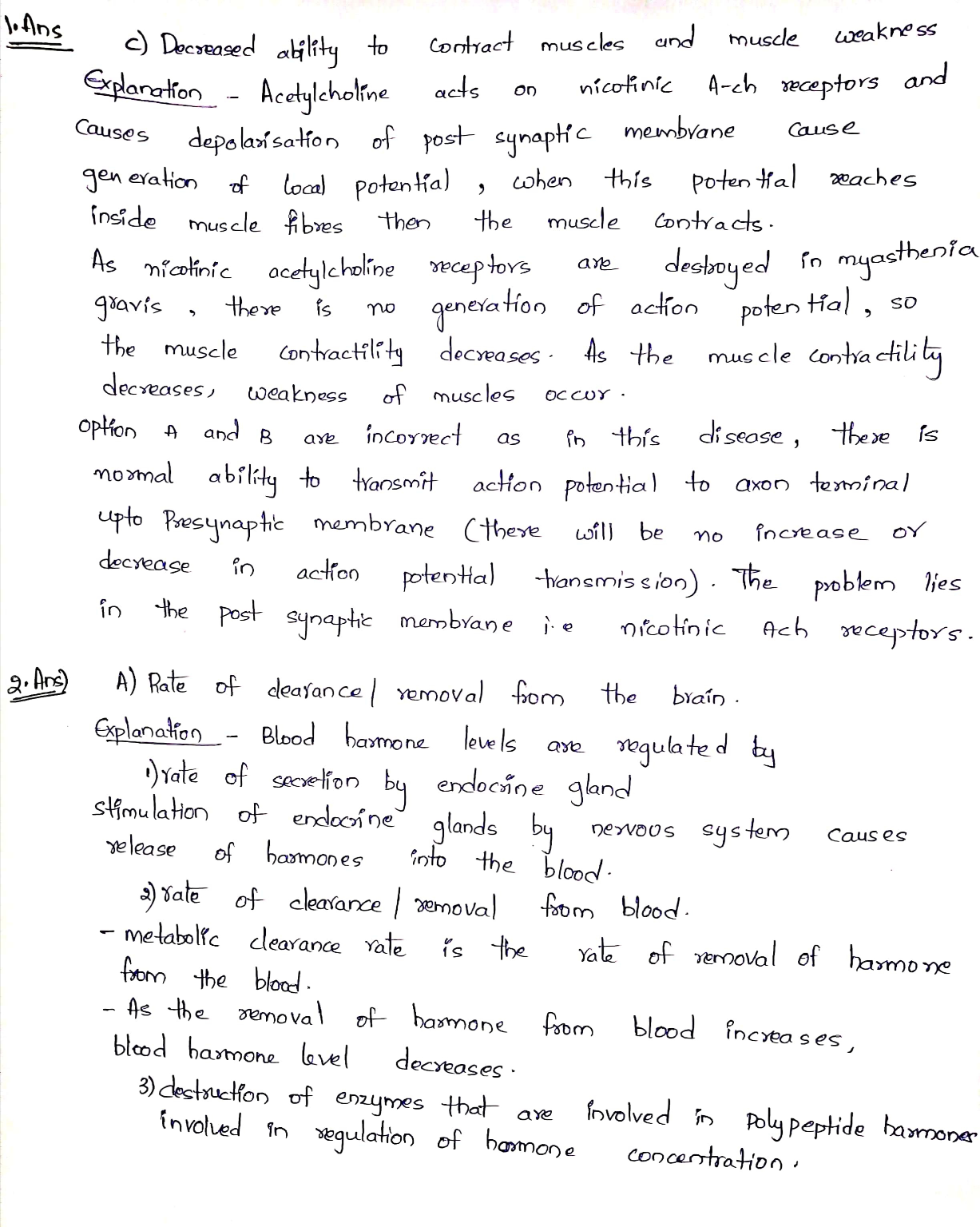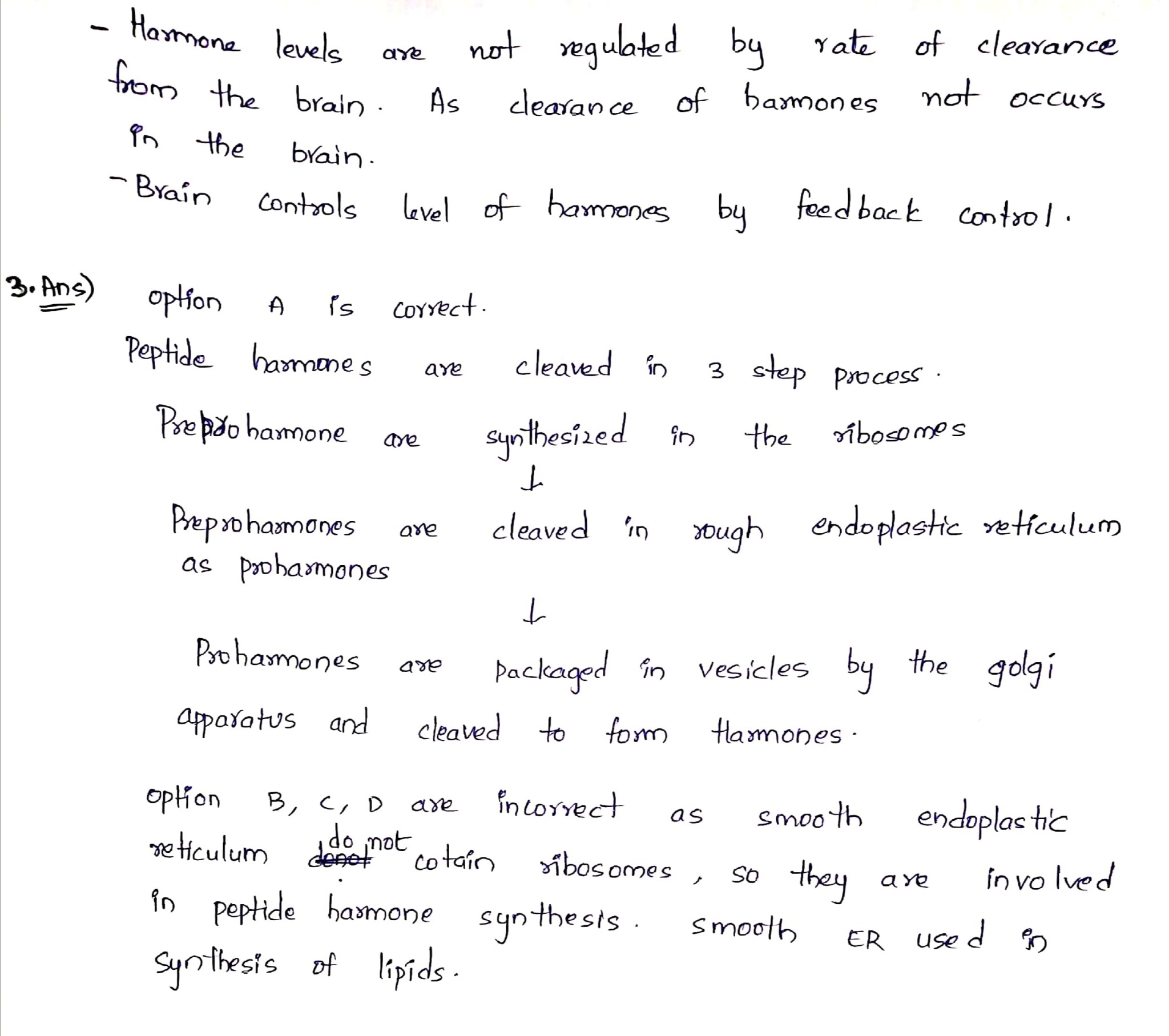Question
In: Anatomy and Physiology
1. Myasthenia Gravis is an autoimmune disease where antibodies slowly destroy the acetylcholine receptors on skeletal...
1. Myasthenia Gravis is an autoimmune disease where antibodies slowly destroy the acetylcholine receptors on skeletal muscle cells. Which of the following would you expect in patients with Myasthenia Gravis?
A. Increased ability to transmit action potentials to the axon terminus
B. Decreased ability to transmit action potentials to the axon terminus
C. Decreased ability to contract muscles and muscle weakness
D. Increased ability to contract muscles and increased muscle strength
2. Concentrations of blood hormone levels are regulated by all except
A. Rate of clearance/removal from the brain
B. Rate of secretion by endocrine gland
C. Rate of clearance/removal from blood
D. Degradation by enzymes in the blood
3. Peptide hormones are cleaved in a 3 step process. Which statement accurately depicts this cleavage process?
A. Preprohormone are synthesized in the ribosomes --> Preprohormones are cleaved in the rough ER as prohormones --> Prohormones are packaged in vesicles by the Golgi Apparatus and cleaved to form hormones
B. Preprohormone are synthesized in the ribosomes --> Preprohormones are cleaved in the rough ER as prohormones --> Prohormones are packaged in vesicles by the mitochondria and cleaved to form hormones
C. Preprohormone are synthesized in the ribosomes --> Preprohormones are cleaved in the smooth ER as prohormones --> Prohormones are packaged in vesicles by the Golgi Apparatus and cleaved to form hormones
D. Preprohormone are synthesized in the smooth ER --> Preprohormones are cleaved in the ribosomes as prohormones --> Prohormones are packaged in vesicles by the Golgi Apparatus and cleaved to form hormones
Solutions
Related Solutions
Myasthenia gravis, an autoimmune disorder, results from the production of antibodies against acetylcholine receptors in the body.
8- Name the primary autoimmune mechanisms in myasthenia gravis Autoantibodies to nicotinic acetylcholine receptors at the...
Myasthenia gravis is a disease that disrupts movement by blocking ACh receptors, preventing them from opening....
1. What is Myasthenia Gravis? 2.What body parts does Myasthenia Gravis affect most? 3. What neurotransmitter...
Ms. Fulton is a 38-year-old mother who was recently diagnosed with myasthenia gravis, a chronic disease...
One treatment for acquired myasthenia gravis is acetylcholinesterase inhibitors. Where do acetylcholinesterase inhibitors have their activity...
Acquired myasthenia gravis is associated with muscle weakness. This muscle weakness is caused by: 1 pt...
4. Multiple sclerosis (MS) is an autoimmune disease in which self-reactive T cells and antibodies attack...
T-cells interact with free antigens. True False An autoimmune disease can develop when antibodies bind to...
Problem 3: Celiac Disease Celiac disease is an autoimmune disorder where the ingestion of gluten leads...
- DataPoint Engineering is considering the purchase of a new piece of equipment for $280,000. It has...
- The Dilana Corporation is considering a change in its cash-only policy. The new terms would be...
- 1. In a local agricultural reporting area, the average wheat yield is known to be 50...
- How do you create your multiple regression formula from your data? I ran my Regression in...
- Following are the post-lab questions for the experiment: Magnetic Behavior and Electron Configuration of Compounds Version...
- Why is documentation, conclusion, and accumulation of audit evidence important for auditors to maintain? Why are...
- topic:- Fundamentals of Databases *********** no hand writing********* If there is photo but photo don’t do...


 Sydney Mullin answered 3 weeks ago
Sydney Mullin answered 3 weeks ago